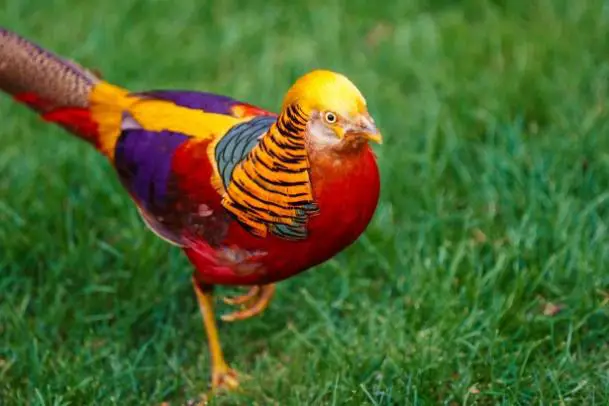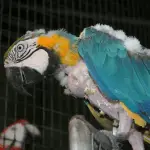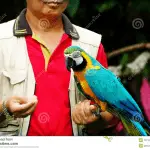Birds are the most amazing creatures. You’ll find birds in different shapes, sizes, and colors. Some birds are plain, but some are very colorful and exotic. If you have never appreciated the beauty of birds, let these seven most exotic birds amaze you.
Rainbow Lorikeet (Trichoglossus moluccanus)
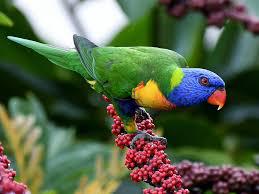
The rainbow lorikeet is a parrot species native to Australia. It is commonly found along with the eastern parts of the country from the northern areas of Queensland to Southern Australia. This colorful parrot can be found in the rainforests, in woodland areas and coastal bushes.
Because of its beauty, rainbow lorikeets are imported to Perth, Tasmania, Western Australia, New Zealand, Auckland, and Hong Kong.
What does the rainbow lorikeet look like?
The rainbow lorikeet is a parrot with a medium-sized build. It can grow from 25 to 30 cm including the tail. The weight of this colorful bird can range from 75 to 157 grams.
The feathers of the rainbow lorikeet are very bright. The head is bright blue; the nuchal collar is greenish yellow while the rest of the body, including the tail, back, and wings, are green. The bird’s chest is yellow/orange while the bird’s belly is bright blue. The thighs, as well as the rump, are green. When in flight, you can easily see the yellow bar on its wings that contrasts with its red underwing.
Male and female rainbow lorikeets are hard to tell apart, but young lorikeets have a large black beak and have dull colors. This beak will eventually brighten to an orange color, and their plumage brighter as they become adults. Only a vet can tell a female rainbow lorikeet from a male one.
Rainbow lorikeet behavior
The rainbow lorikeets are found together, traveling from one feeding spot to another. In flocks, these birds will respond to calls and then disperse in pairs. These colorful birds will defend their feeding as well as their nesting areas in an aggressive manner against other bird species and other groups of rainbow lorikeets. Their manner of driving away intruders is noisy and is similar to other birds like the little wattlebird and the noisy miner. In many areas like suburban gardens, campsites, and campsites, wild birds may be hand-fed. Take birds at the Currumbin Wildlife Sanctuary in Queensland, Australia, where thousands of lorikeets are found. These birds will gather in a very large flock that’s noisy just to be hand-fed by visitors.
Rainbow lorikeet care
When taken as pets, the rainbow lorikeet will make a fine addition to a colorful bird collection. It requires a large area or housing where it can stay with a few companions. This should be followed closely because rainbow lorikeets are very social animals.
The cage should be big enough for your pet to fly about or spread its wings without touching any part of the cage. Its diet of fruit, pollen, and nectar should be strictly followed. This bird has a unique tongue with a papillate appendage at the tip to gather pollen and nectar.
Quetzal
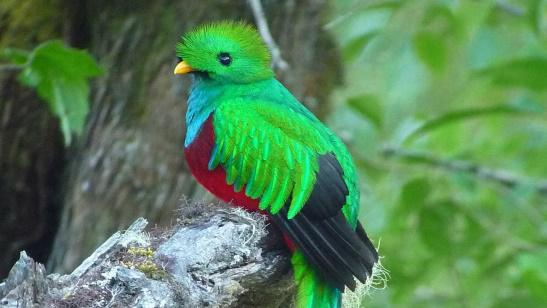
The quetzal is a very colorful bird that lives in forests, most especially in highlands where it’s humid. It is a colored bird that belongs to the trogon family and has five species from the Pharomachrus genus. The following species are quetzal: the eared quetzal found in Mexico and the resplendent quetzal, which is the national bird of Guatemala.
What does the quetzal look like?
The quetzal has very bright, shining green or even golden-green wing covers. This green color also extends to the chest and back while the belly is red. These birds are sexually dimorphic, with some parts of the female’s feathers grey or brown. But despite their very bright plumage, the quetzal is still hard to see from the forest trees and in wooded habitats.
Quetzal behavior
The resplendent quetzal lives alone when it is not breeding, but when it’s breeding season, it sets out to find its mate. During the mating season, the males will grow twin tail feathers that make a wonderful train that can be up to 3 feet in length. Females don’t have this long train, but they also have blue, green, and red colors on their feathers. The male is more colorful than the female.
Quetzal care
It is difficult to take care of a quetzal in captivity, and in fact, those who have tried doing so have failed. In the wild, this majestic bird eats insects mainly but will also eat lizards, small creatures and will also eat fruits.
Golden Pheasant

The golden pheasant (Chrysolophus pictus) is also called the Chinese pheasant and the rainbow pheasant because of its very lovely colors. It is considered a game bird, and its name stands for a bird with a “golden crest.”
What does the Golden Pheasant look like?
The golden pheasant is found in forests, and mountainous areas of The golden pheasant is found in forests and mountainous areas in Western China, but wild groups of golden pheasants are found in the United Kingdom, United States, Mexico, Canada, Peru, Bolivia, Uruguay, Germany, Netherlands, Belgium, Ireland, France, Australia, New Zealand, and the Falkland Islands.
Adult golden pheasants can grow from 90 to 105 cm long, and the tail is two-thirds of its length. The golden crest and the rump is bright and red. It has a deep-orange cape which the bird displays to attract attention. This cape can become a black and orange fan that will cover the face other than its yellow eye with black pupils.
Males are more colorful with a golden-yellow crest with a red tip. The throat, face, chin, and neck are tan. The bird’s wattle and orbital skin are yellow, and the cape is light-orange. The upper back is green while the rest of the bird’s back and rump is yellow. The male has more complicated mixtures of color from its central tail feathers, upper tail coverts, breasts, and lower legs.
Meanwhile, the females are less showy and have duller mottled-brown feathers. Her appearance is darker and more slender compared to a hen with a shorter tail. The breast and the sides are bluff and black-brown while the abdomen is bluff. The face and throat are also bluffs. Both females and months have yellow bills and yellow legs.
Golden Pheasant behavior
Golden Pheasants look for food in the morning and prefer to roost at nighttime. But during winter, when food is scarce, it can wander into human homes, gardens, and fields to eat leaves, grains, and seeds. This bird is unable to fly long distances but can fly in short distances. What they do is to run on the ground to evade predators and also to evade human interaction. If you startle a golden pheasant, it will suddenly fly upwards at high speeds. You will also notice a distinct sound as it flies in short bursts. During the breeding season, this majestic bird has a unique metallic sound or mating call. Golden Pheasant females can lay up to 12 eggs in one time and sit on their eggs around 23 days.
Golden Pheasant care
It is seldom you’ll find private residents caring for golden pheasants, but if you’re lucky enough to do so, make sure to create an environment that mimics its natural environment. Also, feed it the food that it prefers in the wild like berries, seeds, grubs, and other vegetation.
You might find different mutations of the golden pheasant, and this includes the dark-throated pheasant, salmon, yellow, cinnamon, splash, peach, mahogany, and silver. There’s a wild golden pheasant called the red-golden pheasant, and this name was given to differentiate it from the other color mutations.
Bird of Paradise
The bird of paradise is a spectacular member of the Paradisaeidae family, and most individuals of the species are native to New Guinea and in the eastern parts of Australia. The members of the family are known for their colorful and extravagant plumage of the male species. Birds of paradise are sexually dimorphic.
Males of the species have elaborate feathers that can be seen from its beak, head, wings, and tail. The birds of paradise are usually found in thick rainforests. Their diets are fruits, seeds and may also eat small arthropods. Some of the species of birds of paradise are threatened because of habitat destruction and hunting.
What does the Bird of Paradise look like?
Birds of paradise may look similar to corvids and can vary in size from a 50-gram king bird of paradise species to a 430 g curl-crested manucode. Of all the species, the male black sicklebill has the longest tails.
Most male species have larger and longer tails compared to females. The wings of birds of paradise are rounded and may have varying structures depending on the species. When it comes to the bill shape, the beaks can be long and curved, which can be seen in sick bills and species like riflebirds. Some have very small beaks like in Astrapias species. Body sizes vary in the sexes, with females having larger beaks.
The feathers vary between the genders, and this is related to the bird’s breeding system. Manucodes and the paradise crow birds of paradise are socially monogamous and are sexually monomorphic. All the species have black plumage with different amounts of blue and green iridescence. Female plumage may not be as bright as males, but they can blend with their environments. The sexual maturity of birds of paradise can take a long time with some species taking up to 7 years. Sexual maturity depends on the growth of adult plumage.
Bird of Paradise behavior
The diet of this bird is mainly composed of small insects, but they may also eat nectar and large amounts of fruit. This bird is a seed disperser in countries like New Guinea because they eat fruits without digesting seeds. Birds that eat fruits will travel far and wide just to look for food and may join other fruit-eating species in one tree.
The birds of paradise have an elaborate mating ritual with ritualized mating dances, sounds, behavior, and plumage color. Males are polygamous. They also build their nests almost anywhere there’s building material.
Bird of Paradise care
Birds of paradise are not cared for by private individuals and are found mostly in preserves, zoos, and rainforests. A favorite pastime of tourists in the West Papua is to birdwatch these fine feathered creatures. In these areas, tourists are able to absorb Wilson’s bird of paradise, red bird of paradise, Magnificent Riflebird, Kingbird of paradise, and many more species.
Hoopoe
The Hoopoe is a colorful bird that’s native to Afro-Eurasia and is known for its distinct head of feathers. There are several species of the hoopoe, and three of these are still thriving and one already extinct. Hoopoes come in three distinct species: the African hoopoe, Eurasian hoopoe, and the Madagascan hoopoe.
Hoopoes are known to be widespread in Asia, Europe, and North Africa. This cute bird can make seasonal journeys due to rain in some places like what happens in the Western Ghats and Ceylon. Hoopoes live in areas with high elevations during migrations all across the Himalayas. During the first Everest expedition, a hoopoe was recorded at more than 6000 meters.
What does the Hoopoe look like?
The three species of hoopoes have different colors and general appearances. For instance, the African hoopoe can grow up to 28 cm in length and can weigh up to 60 grams. It has a long but decurved beak with black, white, and cinnamon feathers and a stately long crest that can stand up when the hoopoe is alarmed.
The wings of the hoopoe are broad with rounded tips. The female hoopoe has a duller plumage compared to males. Males have less white color found on their secondary feathers. Young hoopoes have dull buff legs and a shorter beak. There is a slightly buff color along with the white wing areas.
Hoopoe behavior
The hoopoe has a distinct voice, which sounds like “Hoop-oop” or may sound like “Hoop-oop-oop.” All the notes in its call have the same pitch. This bird can sunbathe by opening their wings, and their tails are found low on the ground. As the bird maintains this posture, its head is tilted high up. The bird then folds its wings and preen halfway. Aside from sunbathing, the hoopoe also enjoys dust and sand baths. Adults molt when breeding season is over and may continue until they have migrated for warmer lands.
Hoopoes are known to be monogamous; however, the bond of a male and female may last for only a season. Males are capable of making calls, and he does this to declare his territory. Usually, rival males may chase each other and usually, the results are brutal with individuals trying to stab their opponents using their sharp bills. Most of the time, opponents may lose an eye if they are not careful.
Humans consider the hoopoe as pests; however, this bird has a cultural impact on where they thrive. The hoopoe is sacred in Ancient Egypt and was even drawn on walls of temples and tombs. Because of its unique beauty, it is the national bird of Israel.
Hoopoe care
This bird is not usually kept as pets, but if you’re lucky to be able to volunteer for caring for different pets like the hoopoe, then you must provide the correct natural diet for your pet/pets. Their diets are made of insects as well as lizards, frogs, and other smaller reptiles. And if you’re building an enclosure, choose one that will match this bird’s natural habitat.
Kingfisher
The kingfisher is small to a medium-sized bird that has bright, multi-colored plumage. These birds are found in tropical areas in continents like Asia, Africa, and Oceania. There are 114 species, 3 sub-families, and 19 genera.
Kingfishers come with large heads, very long and sharp bills, and stubby tails. Most have very bright feathers, and the male and female of the species only have slight differences. Some kingfishers are tropical, while some live in rainforests. You’ll find these lovely birds diving into the water to eat small invertebrates.
What does the Kingfisher look like?
The kingfisher size and appearance vary depending on the species. You can easily see how bright the colors of the bird’s feathers and this is not due to iridescence or any pigment on the skin but rather the structure of its feathers, which easily scatters the blue light. This phenomenon is the Tyndall effect. In most kingfisher species, there are no differences between the male and female birds. A vet is the only one who can differentiate the female from the male birds.
Generally, kingfishers are birds with very long bills that look like daggers. The bill is longer and compressed compared to those that hunt fish and is shorter compared to species that hunt on land. The kingfisher with the largest bill is the shovel-billed kookaburra. This kingfisher species uses its large bill to dig the forest floor to look for prey. All kingfishers have short legs, but those that feed on the ground have longer legs.
Kingfisher behavior
Kingfishers have brown irises and have good vision. They can use binocular vision and are known to have excellent color perception. These birds can hunt very well in the water and can identify the depth of the water very accurately. A very fine membrane covers the eyes before the bird hits the water.
Kingfisher care
A kingfisher is rarely kept as a pet. But if raised in captivity, it has to be fed with the best food that it can get from its natural environment, including fish, amphibians, mollusks, spiders, reptiles, annelid worms, insects, reptiles, snakes, small mammals, and birds. Different species of kingfishers have different diets, and it all depends on where they live.
Atlantic Puffin
The Atlantic puffin or the common puffin (Fratercula arctica) is a seabird that belongs in the auk family. It is a puffin that thrives in the cold Atlantic Ocean. Two puffin species called the tufted puffin, and horned puffin is found in the north-eastern part of the Pacific.
This cute and colorful bird is seen in Iceland, Greenland, Norway, Newfoundland, and the Faroe Islands. Despite having a large population, the numbers of this puffin are declining, and this has resulted in the IUCN rating it as a vulnerable species. The Atlantic puffin swims on the surface fo the sea and eats on small fish. It can dive underwater and moves using its wings as propulsion.
What does the Atlantic Puffin look like?
The Atlantic Puffin has a steady built and has a thick neck. It can grow up to 30 cm long from its bill to the tail. It has a wingspan of 47 to 63 cm, and while on land, it can stand up to 20 cm tall. The males are larger than females, but it’s difficult to tell them alike.
The crown, forehead, and nape are black with a lovely gloss. The back, tail, and wings are also black. Each side of the head is a pale grey area. Its face has patches that taper to a sharp point that meet at the back of the bird’s neck. The eye looks triangular, but a small patch of skin above and below makes a rectangular shape. The underpants, breasts, under tail and belly, are white.
The beak is very distinct; it is a broad, triangular shape, but from above, it is narrow. The characteristic color of the bird’s bill develops during spring.
Atlantic Puffin behavior
The Atlantic Puffin spends most of its time in the open ocean. It may only visit the coastal areas during the breeding season. It is sociable and is often seen in large colonies. Puffins live in solitary lives when at sea.
Atlantic Puffin care
The Atlantic Puffin is mostly seen in aquariums and zoos. It is rarely kept as pets or in captivity. When in captivity, it should be fed with fish, shrimp, mollusks, crustaceans, and worms. Its enclosure should be huge, with deep water features.
Conclusion
So which exotic bird do you like? It’s hard to decide because each of these birds is captivating as they are interesting to check out. But if you were to keep a bird because of its appearance or its ability to talk, mimic speech, or perform tricks, then why not just admire these birds from a zoo or park? Most of these animals are better left alone but protected nonetheless.
